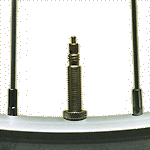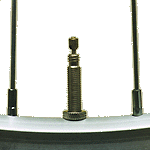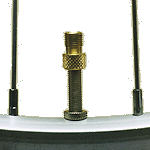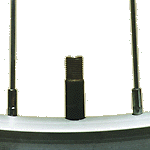

|
Subject: Presta vs Schrader Valves
From: Jobst Brandt
Date: February 21, 2002
 |
 |

|  |
|---|---|---|---|
| Presta valve closed | Presta valve open | Presta valve with adaptor | Schrader valve |
Many valve types have come along since the invention of the pneumatic tire, but for bicycles mainly Presta and Schrader remain in use. The Presta valve is the more slender of the two and is slightly more cumbersome to use, having a lock nut instead of a spring to ensure closure. However, these two features have kept the Presta valve in use on many bicycles.
In the past, sports and racing bicycles used Presta valves because they are slender and enabled racers to inflate tires with a simple pump with attached chuck (pump head) and no hose. Presta valves are easier to pump than Schrader, because they have no valve spring to overcome. Although a valve depressor for Schrader valves can alleviate this, it requires a check valve, impractical to house in lightweight pump heads.
The small diameter of the Presta valve requires a smaller hole in the rim, whose size is important for narrow rims where cross sectional strength of is significantly reduced by a stem hole. In narrow rims, clincher tires also leave insufficient space between tire beads for larger Schrader valves.
In contrast, Schrader valves are more robust, universally used, and have an easily removable core. Spring closure makes them simpler to use because one needs only to press the inflation chuck onto them at an automobile service station. For hand pumps, a screwed or lever chuck provides the valve depressor. The depressor not only makes inflation easier but is necessary to read back pressure in the tire.
[Brandt is of course referring to inflation of automobile tires at a service station. Use of a service-station hose to inflate bicycle tires is risky; see Sheldon's article about flat tires. -- John Allen]
Although Presta valves have been made with removable cores, demand is so small that they are uncommon. Removable Presta cores can be identified by two wrench flats on the coarse valve cap threads.
![]()
More Articles by Jobst Brandt
Next: Rolling Resistance of Tires
Previous: Ideal Tire Sizes
![]()
![]()
Last Updated: by John Allen